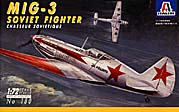
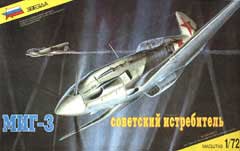
|
|
|
|
Some of these notes are partially based on works of Scott M. Head, Roger
Wallsgrove and Tom Cleaver


|
|
|
|
|
This kit is pretty decent at first glance, with panel lines engraved,
but a more in-depth inspection shows that it suffers from severe shape
and contour problems, and hardly resembles a MiG-3.
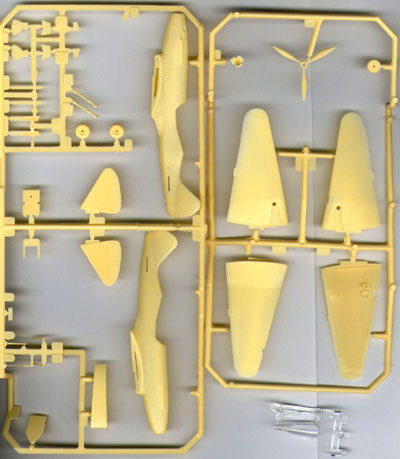
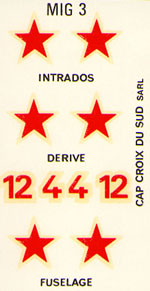
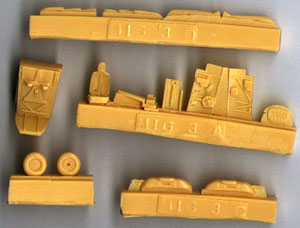
The wings are too thick at the root and too bended. The profile of
the tail surfaces is unaccurate, and resembles vaguely as on I-230. The
radiator is much too short, sharp and not faired into the undersurface
properly, and the nose of the aircraft in much too slender. The intakes
on the kit are incorrectly symmetrical, they should be asymmetrical. The
spinner is too small, and the propeller is horrible.
Inside the cockpit you get a basic seat, floor, instrument panel and
control column.
The sliding part of the canopy is too narrow and low on its rear side,
and not long enough; totally wrong, and only the windshield is usable.
The rear fuselage is too narrow, as well. The overall fuselage is a bit
too long and narrow also. The guns are moved in atoo lateral position.
The undercarriage legs, doors and wheels are too small.
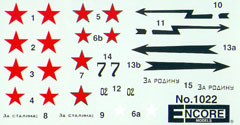
The Encore kits (3 variants differing for the decals sheet) include
apparently good decals (not too accurate, on closer examination; the wide
arrows, the 02, the Za Rodinu slogan should be red, not black) alongside
the old Cap Croix de Sud sheet, and resin pieces for cockpit interior,
wheels, exhaust pipes, underwing guns and side intakes, but these pieces
are not very faithful to the original, and can't transform these kits into
accurate ones.
|
|
|
 -
-
This kit is an early Frog design never commercialized with this trademark.
It is a simple kit; inside the cockpit you get a basic seat, stick, and
floor. The shape of this kit is fairly good. The sliding canopy rear strut
is vertical, while it should be oblique; the wheels and main undercarriage
legs are too thin, the tail wheel is fixed (it is acceptable for very late
production aircrafts). The kit represents a compromise between an
early type and a late type, with long gun fairings but some other early
characteristics, such as side slots; the exhaust pipes are moulded on the
fuselage, and not realistic.

Overall, this kit is obsolete, even if not completely negative; it
is reasonably easy to build, and could be acceptable for a relaxing work.
|
|
|
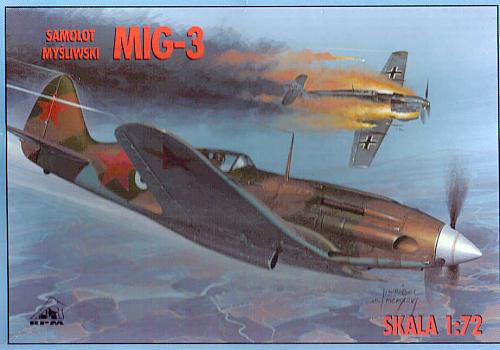 |
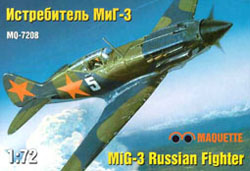 |
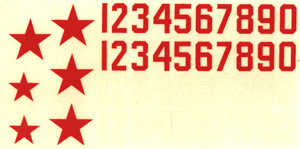
Building the the Maquette/RPM kit
|
|
|
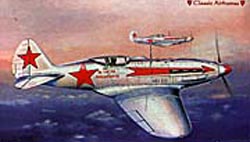

The fit is pretty good for a limited run kit, and flash was minimal.
The vacuformed canopy looks like it will fit well.
The vertical tail looks thick - easy enough to thin down but be careful
since the fuselage upper joint line has a 'jog' to accomodate the canted
stabilizer.
The surface is relatively smooth, but as with all limited run kits
there are a few glitches to sand out.
The excellent resin cockpit is handled with a three-wall tub with almost
all detail molded in, plus a resin seat and control column; photoetch is
limited to the instrument panel, seat belts, little odds and ends, and
very nice wheel hubs.
I'd use True Details wheels for a more dimesional wheel, but remove
the tread and thicken the tire by 1mm with a spacer between the halves
(you'll have to saw the wheels in two yourself).
Two markings choices are provided: a dark green over light blue aircraft
with a white Cyrillic '5', and the aircraft in winter-scheme white over
light blue with elongated arrow over the exhaust stacks, with a choice
of patriotic slogans.
I've identified many white examples in
this photo, and they're all the late version, while the kit represents
the early version. I've failed to identify the green example, it could
be the hypothetical early Pokryshin's MiG, seen on many drawings but never
documented by photos.
For an article on the building of the Flashback kit, see:
http://www.kitparade.com/features00/mig3ws_1.htm
|
|
This kit represents the late version; it is highly detailed, with recessed
surface details, separate slats, underwing rockets and underwing gun pods.
A complete engine is included; it comes as 20-odd parts, including
engine ancillaries and engine mount.
Be careful--do not try to install the closed cowling over the engine.
It doesn't fit because of the plastic parts' thickness. You should put
on the engine only if you make the cowling open, otherwise you have to
omit it.
The most rational way to build the kit is to make two sub-assemblies-
fuselage and wings-, glue and let them dry, and then join them. Using the
necessary care, the fit is good.
The struts of the movable surfaces are too sharp and must be modified
to give the idea of fabric-covered struts.
This kit is sold by ICM in at least 4 different boxes:
| The aircraft alone; this kit features a decals sheet for 10 examples,
5 of them white painted, the other with camouflage colors.
go to ICM kit painting sheet |
 |
| The aircraft of the ace Krasnov, with pilots and ground crew enclosed. I have not seen the decals sheet. |  |
| A triple box with the MiG-3, Spitfire Mk-IX, and Yak-7 with "Baltic
Fleet" decals; it encloses 10 figures and some ground equipment, also.
I have not seen the decals sheet; the MiG should have white 42 decals. |
 |
| Another triple kit with the "defence of Moscow" decals, with 10 figures
and ground equipment enclosed.
go to "Moscow air defence" decals sheet |
 |
An article describing the kit and some minor fit difficulties can be
found here.
http://www.kitparade.com/features00/mig3ir_1.htm
The Russian tabloid "Modelizm 4/2000" has an article (that I couldn't
read) with some sketch drawings, that surely show some small corrections
to do and are reproduced here.
http://ic.moris.ru/~grigory/plastik/recenz/mig3/mig3.html
| WARNING!
Someone had bad experiences with masking and spraying ICM canopies. Using liquid masking media (Maskol & others) coupled with sprayed acrylic paints, there has been an unpleasant reaction between the masking and the paint, leading to damage to the plastic. The use of tape, BareMetal foil or Parafilm masking is therefore recommended instead - and check that your chosen paint doesn’t react with ICM’s clear parts! |
|
|
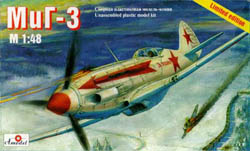 |
This is correct in shape and size and represents the late version with decals for 7 examples, but the quality of detail, trasparent canopy and fitting is poor, and is not match for the ICM kit. |
|
|
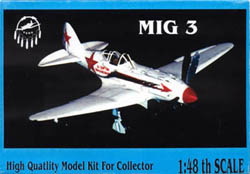 |
This resin kit is produced in two versions, both for early type and
for late type MiG-3.
It is said to be good. A review can be found at http://www.internetmodeler.com/2001/may/first-looks/pomk_mig3.htm |
|
|
| The Chinese firm Trumpeter is releasing a 1/32 kit. I haven't examined
it yet, but here
is a quick review with some images of the box, of the instructions
sheet and of sprues.
We see that the kit has decals for two examples, the famous white example with red arrow and the slogan Za Rodinu, and the supposed white 5 of Pokryshkin; this latter is not documented by any photo. By the photos, we see that the model has excellent recessed surface details, fully movable surfaces (it is the only kit having movable flaps), good details of the cockpit, exhaust stack with holes. It is armed by six underwing rockets. The kit includes some photoetched nervures and some rod to detail the flaps inner side. The hole on the fuselage where the elevator shaft passes is not reproduced. The canopy is divided into three clear pieces; I don't know if the sliding part is thin enough to be mounted open. |
| The following link is to a photo gallery of a built model on the site
of Trumpeter.
trumpeter-china.com/ch/menu/cppic/02230/index.htm The excellent photos give a good impression of the model, that looks
accurate in shape and in most details. Only the spinner should be slightly
more conical.
|
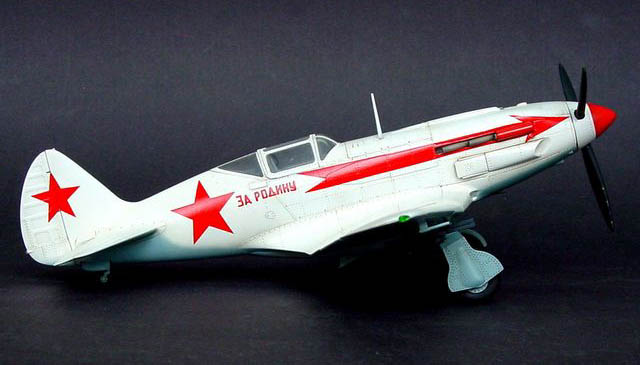 |
|
|